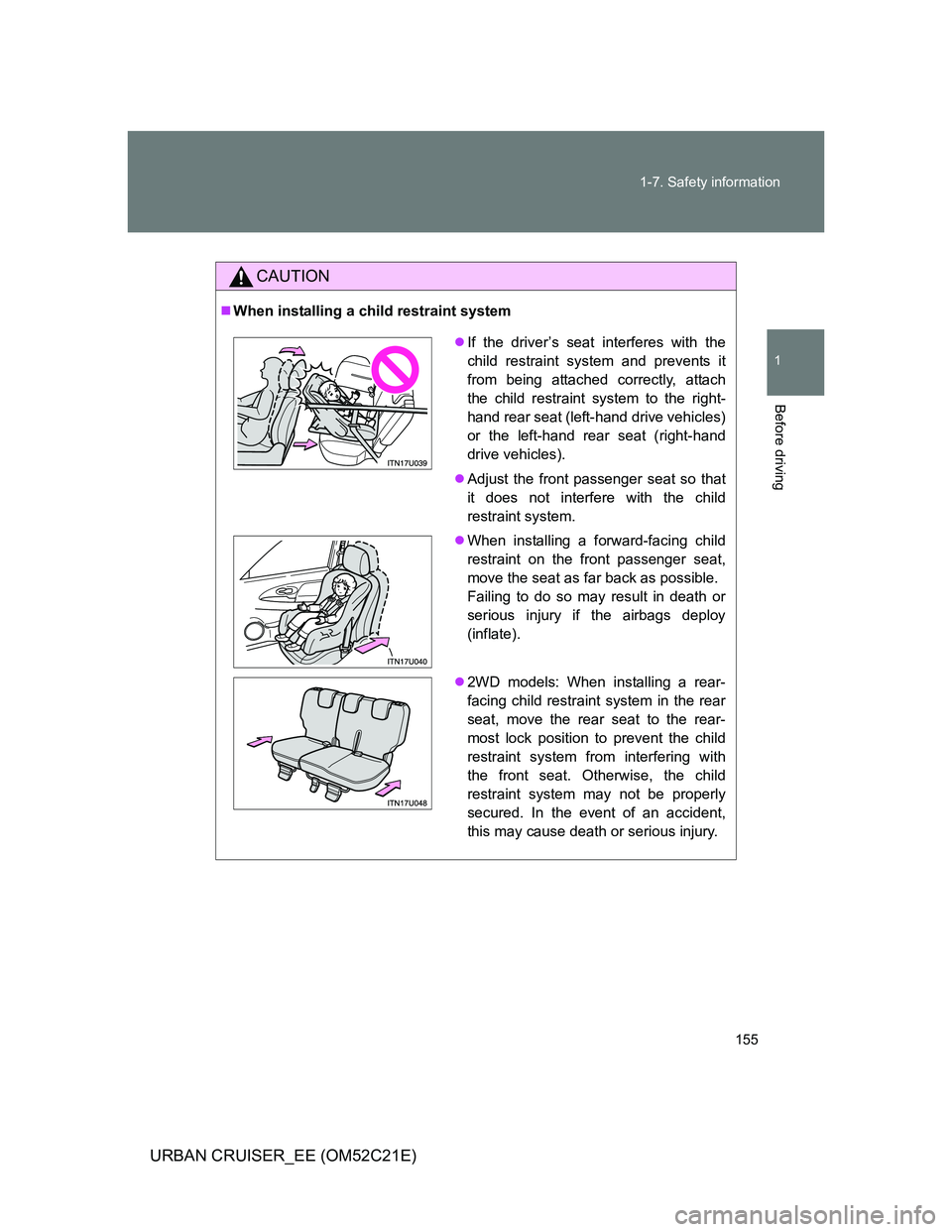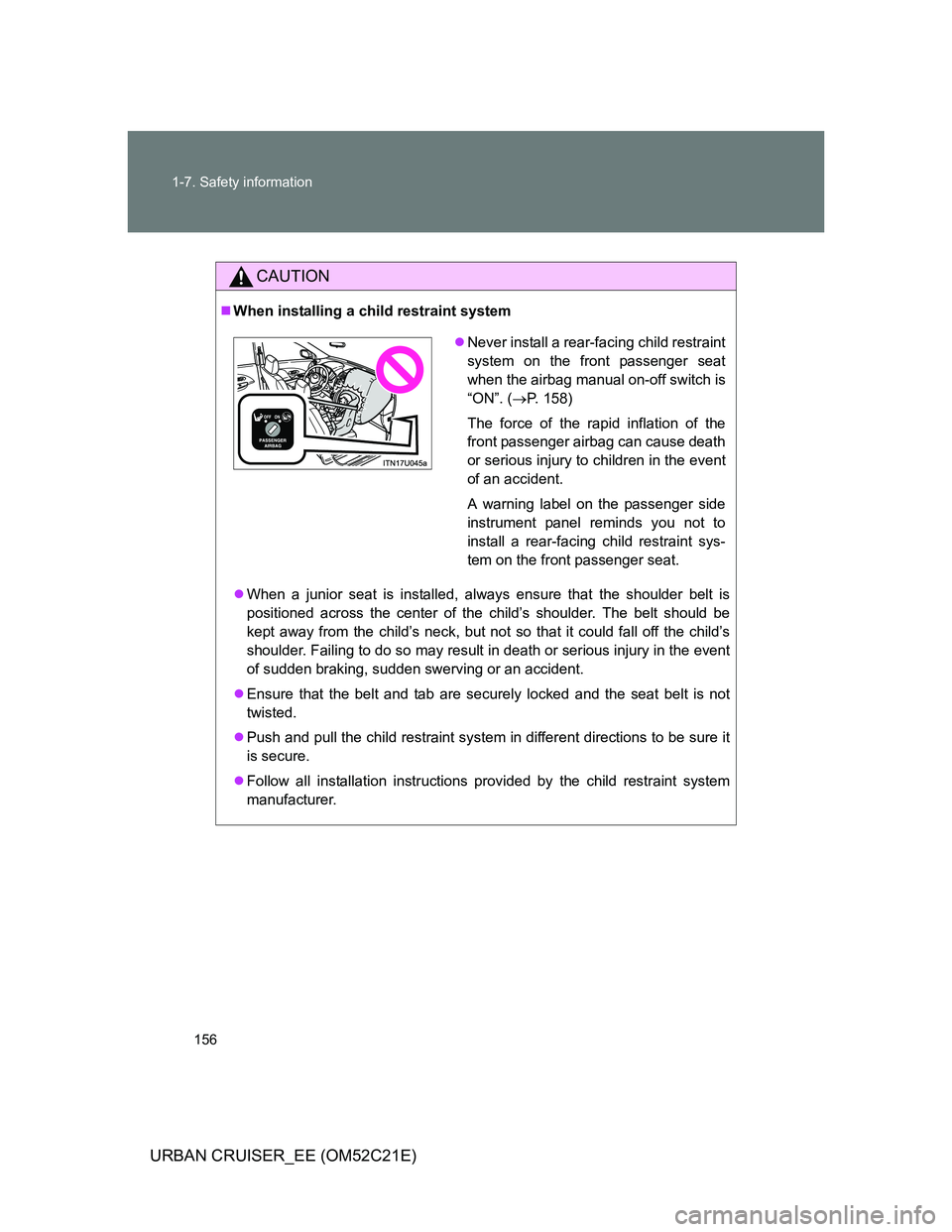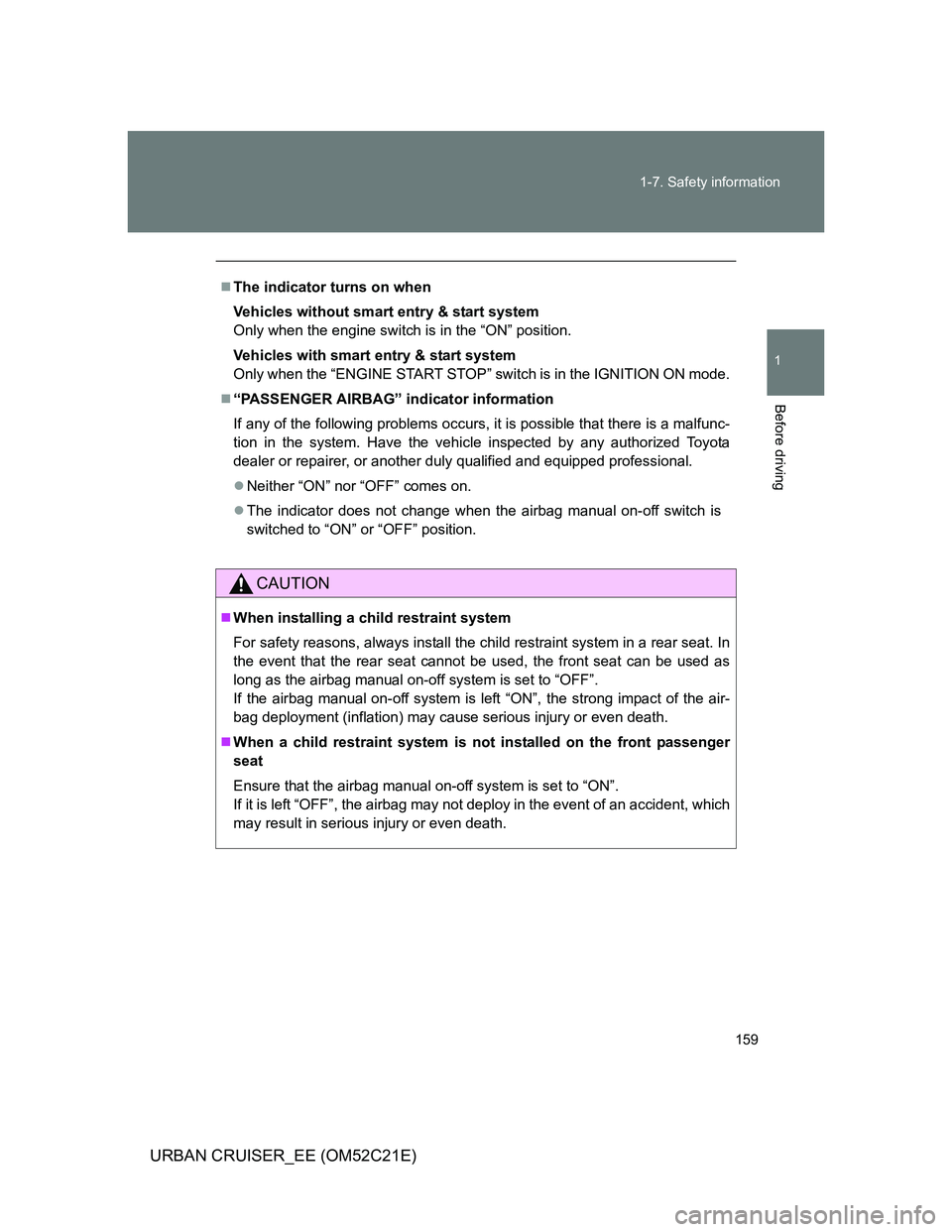Page 139 of 532
139 1-7. Safety information
1
Before driving
URBAN CRUISER_EE (OM52C21E)
Child restraint system suitability for various seating positions
Provided information in the table shows your child restraint system
suitability for various seating positions.
Front passenger
seat
Rear seat
Airbag manual
on-off switch
ON
OFFOutside Center
0
Up to 10 kg
(22 lb.)
(0 - 9 months)X
Never putUUU
0
+
Up to 13 kg
(28 lb.)
(0 - 2 years)X
Never putUUU
I
9 to 18 kg
(20 to 39 lb.)
(9 months - 4
years)Front
facing —
UF
UUU
Rear
facing — X
Never put
II, III
15 to 36 kg
(34 to 79 lb.)
(4 - 12 years)UFUUU
Mass groupsSeating
position
Page 143 of 532

143 1-7. Safety information
1
Before driving
URBAN CRUISER_EE (OM52C21E)
Selecting an appropriate child restraint system
Get an appropriate child restraint system for the child. If a child is too large
for a child restraint system, sit the child on a rear seat and use the vehicle’s
seat belt. (P. 85)
CAUTION
Using a child restraint system
The use of a child restraint system not suitable for the vehicle may not prop-
erly secure the infant or child, resulting in serious injury or even death.
Child restraint precautions
For effective protection in automobile accidents and sudden stops, a child
must be properly restrained, using a seat belt or child restraint system
depending on the age and size of the child. Holding a child in your arms is
not a substitute for a child restraint system. In an accident, the child can be
crushed against the windshield, or between you and the vehicle’s interior.
Toyota strongly urges the use of a proper child restraint system that con-
forms to the size of the child, installed on the rear seat. According to acci-
dent statistics, the child is safer when properly restrained in the rear seat
than in the front seat.
Never install a rear-facing child restraint system on the front passenger
seat when the airbag manual on-off switch is “ON”. (P. 158)
In the event of an accident, the force of the rapid inflation of the front pas-
senger airbag can cause death or serious injury to the child.
Page 144 of 532

144 1-7. Safety information
URBAN CRUISER_EE (OM52C21E)
CAUTION
Child restraint precautions
A forward-facing child restraint system should be allowed to be installed
on the front passenger seat only when it is unavoidable. Always move the
seat as far back as possible, because the front passenger airbag could
inflate with considerable speed and force. Otherwise, the child may be
killed or seriously injured.
Do not allow the child to lean his/her head or any part of his/her body
against the door or the area of the seat, front and rear pillars or roof side
rail from which the side airbags or curtain shield airbags deploy even if the
child is seated in the child restraint system. It is dangerous if the side air-
bags and curtain shield airbags inflate, and the impact could cause death
or serious injury to the child.
Make sure you have complied with all installation instructions provided by
the child restraint manufacturer and that the system is properly secured. If
it is not secured properly, it may cause death or serious injury to the child
in the event of a sudden stop, sudden swerve or an accident.
When children are in the vehicle
Do not allow children to play with the seat belt. If the seat belt becomes
twisted around a child’s neck, it may lead to choking or other serious injuries
that could result in death.
If this occurs and the buckle cannot be unfastened, scissors should be used
to cut the belt.
When the child restraint system is not in use
Keep the child restraint system properly secured on the seat even if it is
not in use.
Do not store the restraint unsecured in the passenger compartment.
If it is necessary to detach the child restraint system, remove it from the
vehicle or store it securely in the luggage compartment. This will prevent it
from injuring passengers in the event of a sudden stop, sudden swerve or
an accident.
Page 155 of 532

155 1-7. Safety information
1
Before driving
URBAN CRUISER_EE (OM52C21E)
CAUTION
When installing a child restraint system
If the driver’s seat interferes with the
child restraint system and prevents it
from being attached correctly, attach
the child restraint system to the right-
hand rear seat (left-hand drive vehicles)
or the left-hand rear seat (right-hand
drive vehicles).
Adjust the front passenger seat so that
it does not interfere with the child
restraint system.
When installing a forward-facing child
restraint on the front passenger seat,
move the seat as far back as possible.
Failing to do so may result in death or
serious injury if the airbags deploy
(inflate).
2WD models: When installing a rear-
facing child restraint system in the rear
seat, move the rear seat to the rear-
most lock position to prevent the child
restraint system from interfering with
the front seat. Otherwise, the child
restraint system may not be properly
secured. In the event of an accident,
this may cause death or serious injury.
Page 156 of 532

156 1-7. Safety information
URBAN CRUISER_EE (OM52C21E)
CAUTION
When installing a child restraint system
When a junior seat is installed, always ensure that the shoulder belt is
positioned across the center of the child’s shoulder. The belt should be
kept away from the child’s neck, but not so that it could fall off the child’s
shoulder. Failing to do so may result in death or serious injury in the event
of sudden braking, sudden swerving or an accident.
Ensure that the belt and tab are securely locked and the seat belt is not
twisted.
Push and pull the child restraint system in different directions to be sure it
is secure.
Follow all installation instructions provided by the child restraint system
manufacturer.
Never install a rear-facing child restraint
system on the front passenger seat
when the airbag manual on-off switch is
“ON”. (P. 158)
The force of the rapid inflation of the
front passenger airbag can cause death
or serious injury to children in the event
of an accident.
A warning label on the passenger side
instrument panel reminds you not to
install a rear-facing child restraint sys-
tem on the front passenger seat.
Page 158 of 532
158
1-7. Safety information
URBAN CRUISER_EE (OM52C21E)
Airbag manual on-off system
Deactivating the front passenger airbag
Insert the key into the cylinder
and rotate to the “OFF” position.
The “OFF” indicator turns on.
This system deactivates the front passenger airbag.
Only deactivate the airbag when using a child restraint system on
the front passenger seat.
“PASSENGER AIRBAG” indi-
cator
This indicator turns on when
the airbag system is “ON”.
Airbag manual on-off switch
Page 159 of 532

159 1-7. Safety information
1
Before driving
URBAN CRUISER_EE (OM52C21E)
The indicator turns on when
Vehicles without smart entry & start system
Only when the engine switch is in the “ON” position.
Vehicles with smart entry & start system
Only when the “ENGINE START STOP” switch is in the IGNITION ON mode.
“PASSENGER AIRBAG” indicator information
If any of the following problems occurs, it is possible that there is a malfunc-
tion in the system. Have the vehicle inspected by any authorized Toyota
dealer or repairer, or another duly qualified and equipped professional.
Neither “ON” nor “OFF” comes on.
The indicator does not change when the airbag manual on-off switch is
switched to “ON” or “OFF” position.
CAUTION
When installing a child restraint system
For safety reasons, always install the child restraint system in a rear seat. In
the event that the rear seat cannot be used, the front seat can be used as
long as the airbag manual on-off system is set to “OFF”.
If the airbag manual on-off system is left “ON”, the strong impact of the air-
bag deployment (inflation) may cause serious injury or even death.
When a child restraint system is not installed on the front passenger
seat
Ensure that the airbag manual on-off system is set to “ON”.
If it is left “OFF”, the airbag may not deploy in the event of an accident, which
may result in serious injury or even death.
Page 193 of 532
193 2-2. Instrument cluster
2
When driving
URBAN CRUISER_EE (OM52C21E)
Indicators
The indicators inform the driver of the operating state of the
vehicle’s various systems.
Turn signal indicator
(P. 187)
(if equipped)
“ECO” indicator
(P. 2 1 1 )
Headlight high beam
indicator (P. 202)
(if equipped)
“ECO OFF” indicator
(P. 2 1 1 )
Tail light indicator
(P. 201)
(4WD models)
Four-wheel drive lock
indicator (
P. 223)
(if equipped)
Front fog light indicator
(P. 205)Low engine coolant
temperature indicator
Rear fog light indicator
(P. 205)
(if equipped)
“VSC OFF” indicator
(P. 219)
(if equipped)
Slip indicator (P. 218)
(diesel engine)
Engine preheating
indicator (P. 179, 175)
Gear Shift Indicator
(P. 184)“PASSENGER
AIRBAG” indicator
(P. 158)
*1
*1
*1
*1, 4
*1, 2
*1*1